External Controls
Inspection and Verification
- Verify the customer concern by operating the system.
- Visually inspect for obvious signs of mechanical or electrical damage.
- If the concern is not visually evident, verify the symptom. GO to Symptom Chart.
Visual Inspection Chart
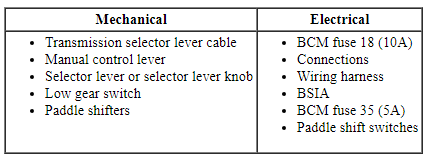
DTC Chart
Diagnostics in this manual assume a certain skill level and knowledge of Ford-specific diagnostic practices. Refer to Diagnostic Methods in Section 100-00 for information about these practices.
DTC Chart - BCM

DTC Chart - PCM

Symptom Chart
Diagnostics in this manual assume a certain skill level and knowledge of Ford-specific diagnostic practices. Refer to Diagnostic Methods in Section 100-00 for information about these practices.
In most circumstances, the PCM sets DTCs to help guide with diagnostics. Refer to the DTC Chart before using the symptom chart. The Condition column lists the vehicle condition. The Source column lists a detailed vehicle condition. The Action column lists the action to be performed to determine the cause of the condition. Each action lists the components that can caused the system and the individual components in that system. The components are listed in order of disassembly. Use the list of components and the required action to focus on disassembly inspections for the root cause of the concern.
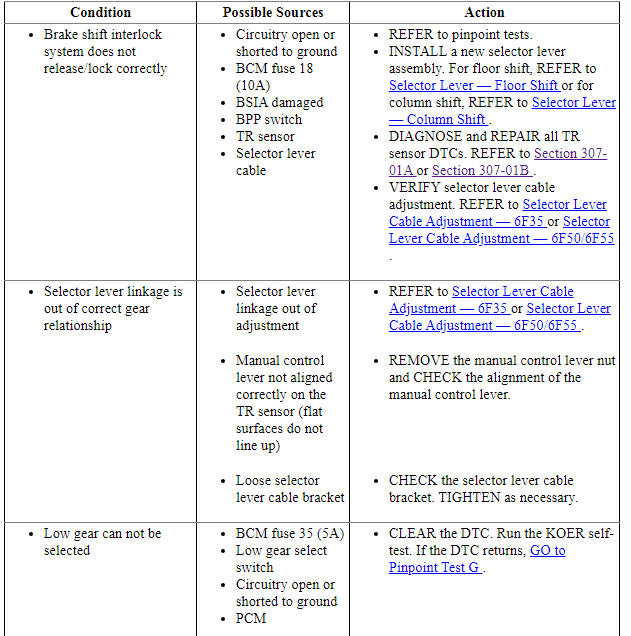

Pinpoint Tests
Pinpoint Test A: B1319:11 (Floor Shift)
Diagnostic Overview
Diagnostics in this manual assume a certain skill level and knowledge of Ford-specific diagnostic practices. Refer to Diagnostic Methods in Section 100-00 for information about these practices.
Refer to Wiring Diagrams Cell 37 , Shift Interlock for schematic and connector information.
Normal Operation and Fault Conditions
The BSIA system is controlled by the BCM and is activated when the BCM receives a brake pedal applied input.
DTC Fault Trigger Conditions

-
Possible Sources
- Connectors damaged or pushed-out terminals, corrosion, loose wires and missing or damaged seals.
- BSIA solenoid
- Fuse
- BCM
PINPOINT TEST A: B1319:11 (FLOOR SHIFT)
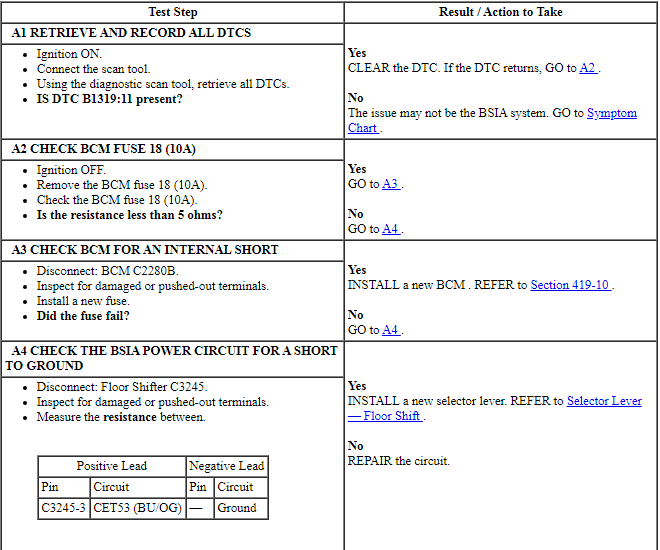
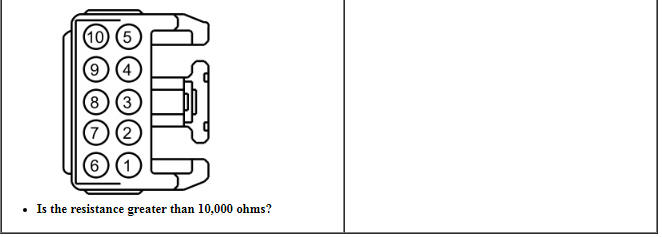
Pinpoint Test B: B1319:15 (Floor Shift)
Diagnostic Overview
Diagnostics in this manual assume a certain skill level and knowledge of Ford-specific diagnostic practices. Refer to Diagnostic Methods in Section 100-00 for information about these practices.
Refer to Wiring Diagrams Cell 37 , Shift Interlock for schematic and connector information.
Normal Operation and Fault Conditions
The BSIA system is controlled by the BCM and is activated when the BCM receives a brake pedal applied input.
DTC Fault Trigger Conditions

-
Possible Sources
- Connectors damaged or pushed-out terminals, corrosion, loose wires and missing or damaged seals.
- BSIA solenoid
- Fuse
- BCM
PINPOINT TEST B: B1319:15 (FLOOR SHIFT)
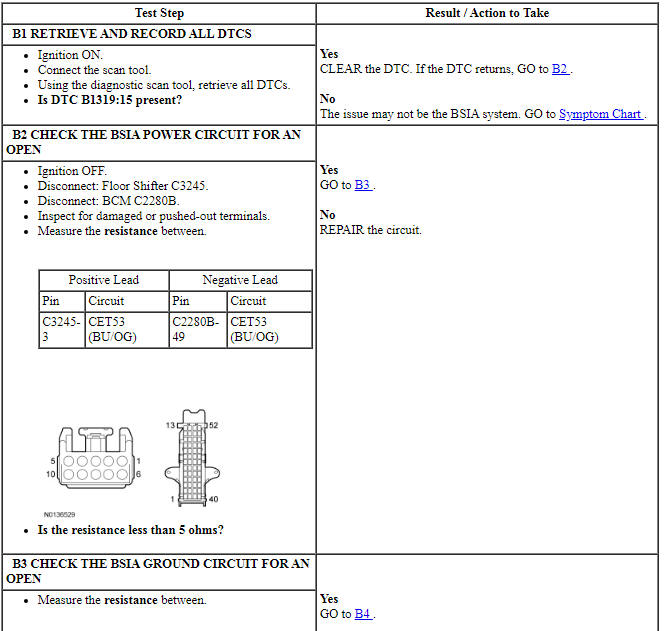
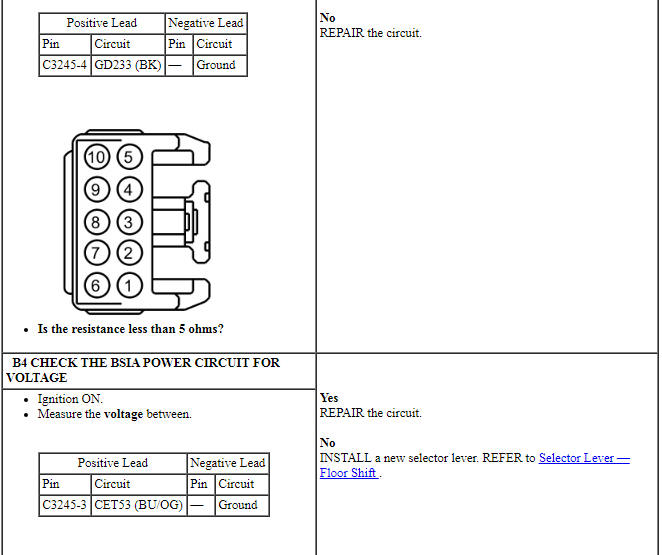
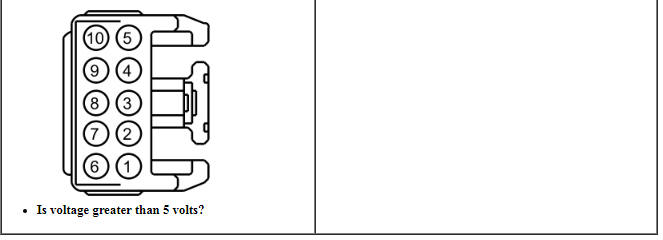
Pinpoint Test C: B1319:11 (Column Shift)
Diagnostic Overview
Diagnostics in this manual assume a certain skill level and knowledge of Ford-specific diagnostic practices. Refer to Diagnostic Methods in Section 100-00 for information about these practices.
Refer to Wiring Diagrams Cell 37 , Shift Interlock for schematic and connector information.
Normal Operation and Fault Conditions
The BSIA system is controlled by the BCM and is activated when the BCM receives a brake pedal applied input.
DTC Fault Trigger Conditions

-
Possible Sources
- Connectors damaged or pushed-out terminals, corrosion, loose wires and missing or damaged seals.
- BSIA solenoid
- Fuse
- BCM
PINPOINT TEST C: B1319:11 (COLUMN SHIFT)
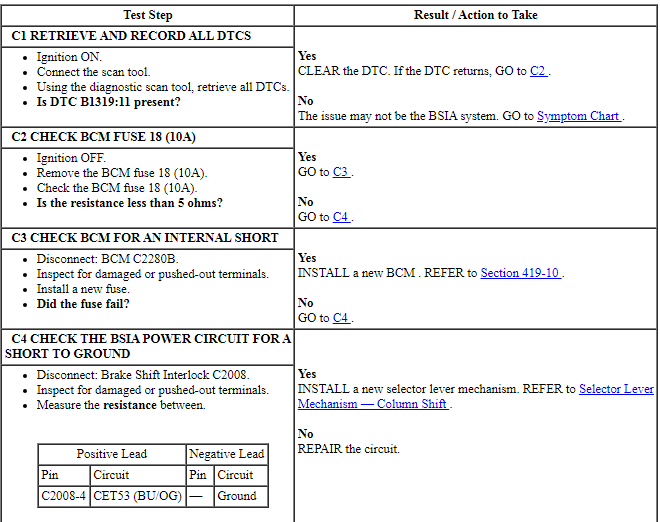
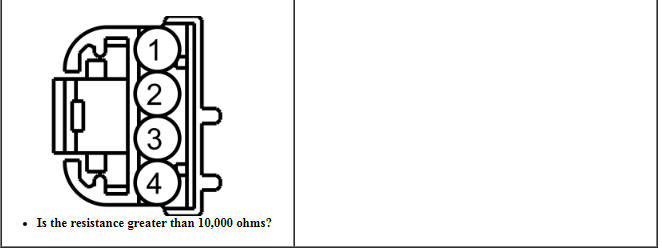
Pinpoint Test D: B1319:15 (Column Shift)
Diagnostic Overview
Diagnostics in this manual assume a certain skill level and knowledge of Ford-specific diagnostic practices. Refer to Diagnostic Methods in Section 100-00 for information about these practices.
Refer to Wiring Diagrams Cell 37 , Shift Interlock for schematic and connector information.
Normal Operation and Fault Conditions
The BSIA system is controlled by the BCM and is activated when the BCM receives a brake pedal applied input.
DTC Fault Trigger Conditions

-
Possible Sources
- Connectors damaged or pushed-out terminals, corrosion, loose wires and missing or damaged seals.
- BSIA solenoid
- Fuse
- BCM
PINPOINT TEST D: B1319:15 (COLUMN SHIFT)
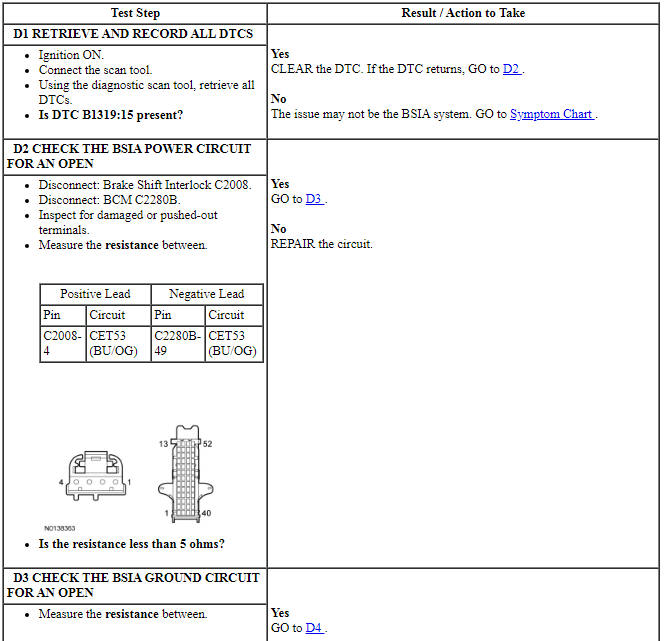
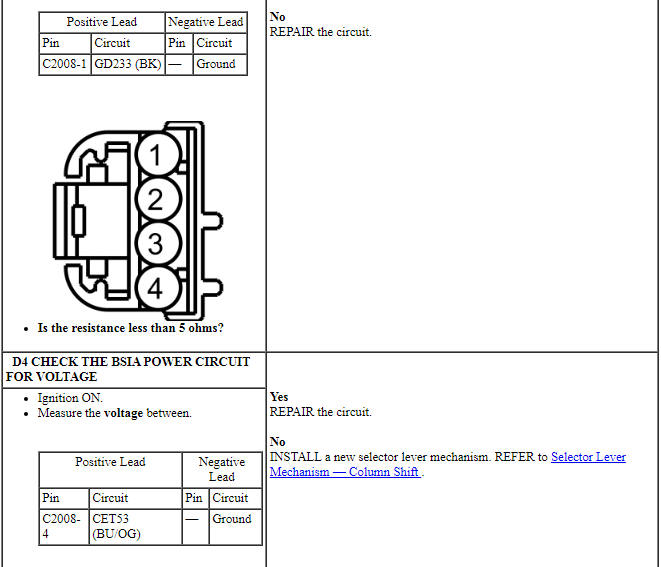
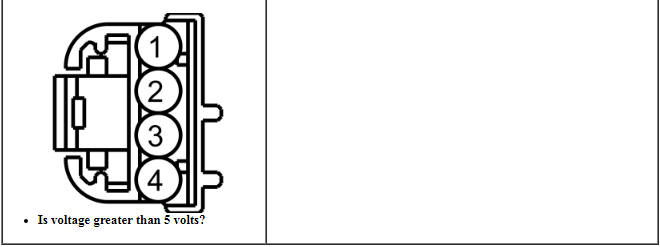
Pinpoint Test E: P0815, P0816 (Floor Shift)
Diagnostic Overview
Diagnostics in this manual assume a certain skill level and knowledge of Ford-specific diagnostic practices. Refer to Diagnostic Methods in Section 100-00 for information about these practices.
Refer to Wiring Diagrams Cell 29 , Transmission Controls - 6 Speed for schematic and connector information.
Normal Operation and Fault Conditions
The SelectShift switch is a toggle switch integral to the selector lever knob. When the selector lever is placed in the manual shift position, the upshift/downshift feature becomes activated. If a new switch is required install a new selector lever knob.
DTC Fault Trigger Conditions

-
Possible Sources
- Connectors damaged or pushed-out terminals, corrosion, loose wires and missing or damaged seals.
- SelectShift switch
- PCM
PINPOINT TEST E: P0815, P0816 (FLOOR SHIFT)
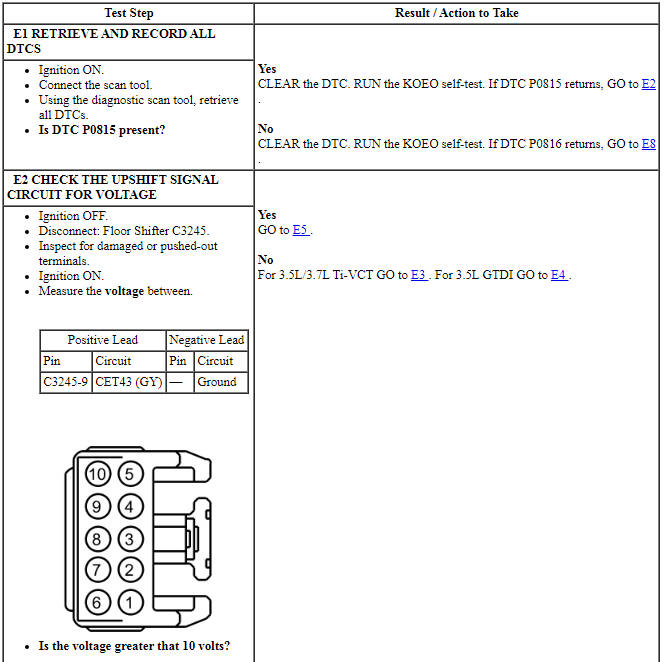
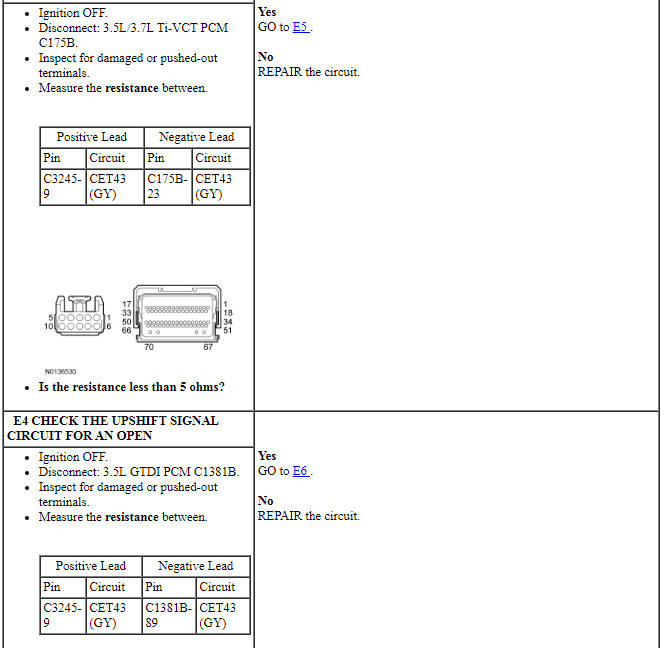
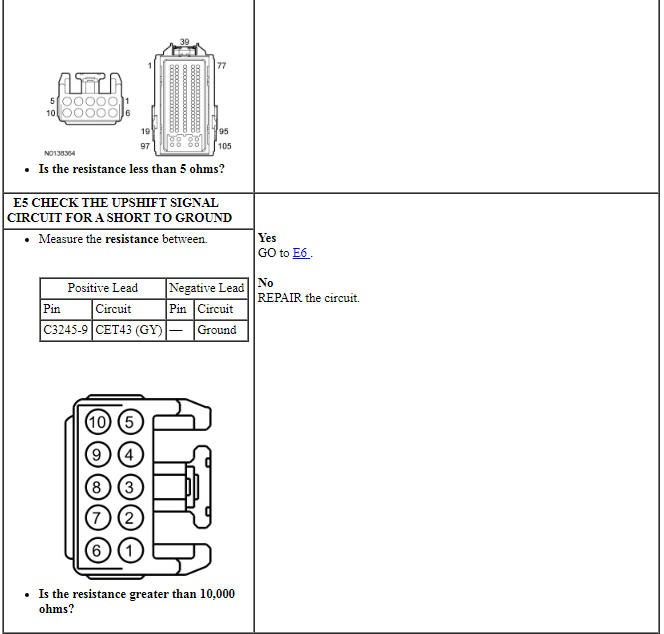
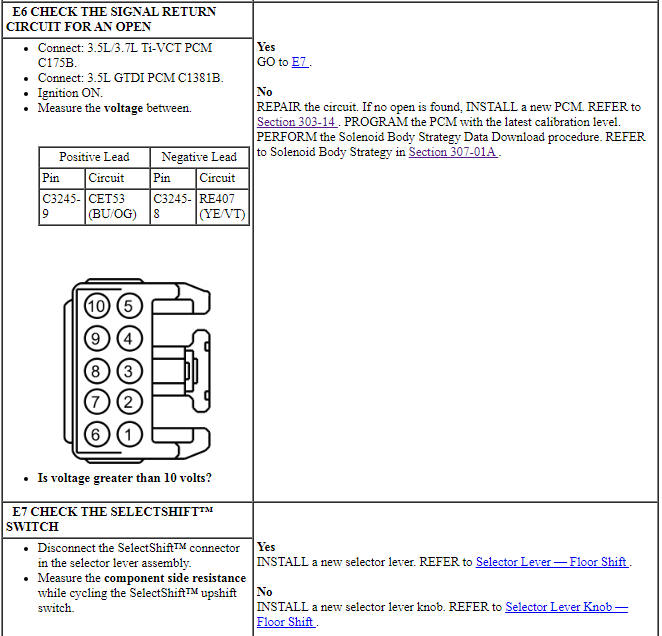
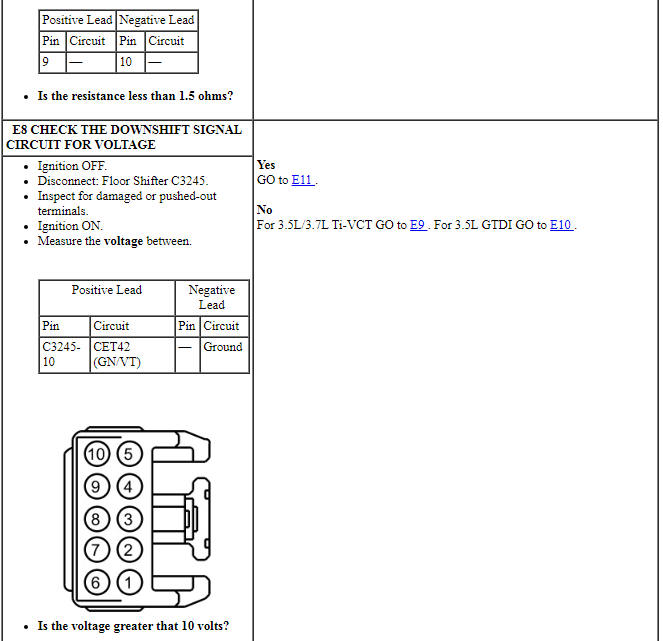
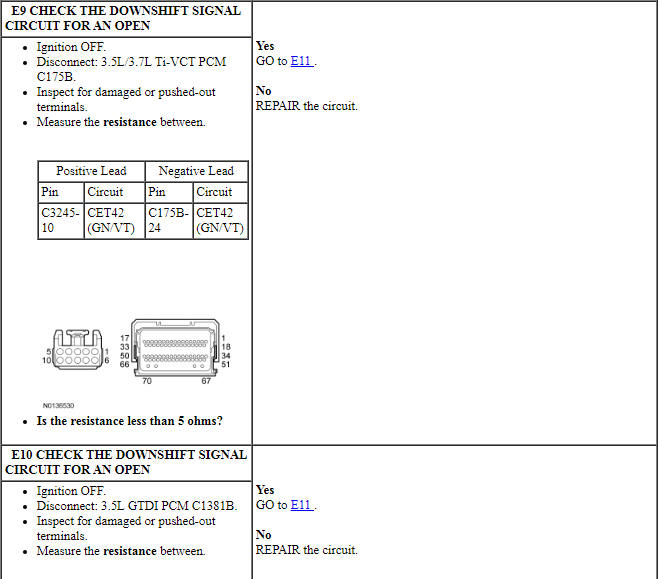
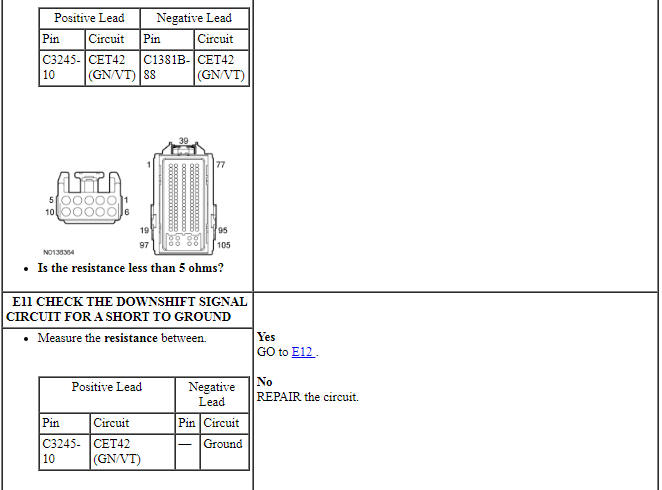
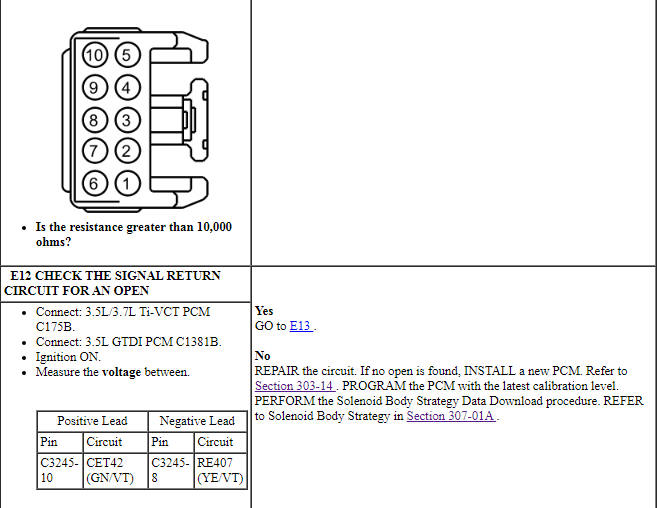
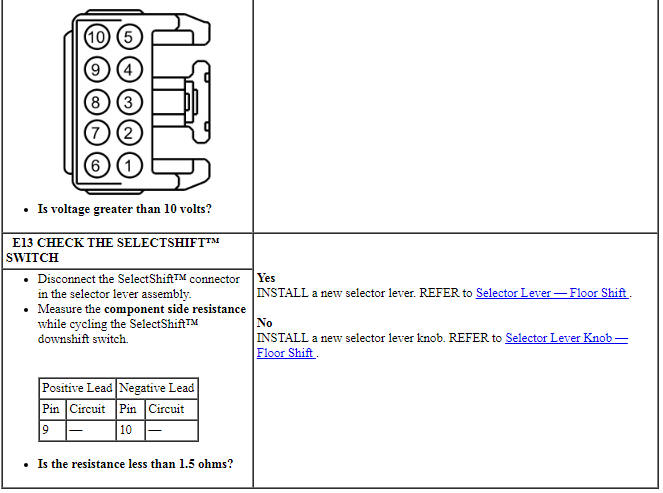
Pinpoint Test F: P0815, P0816 (Paddle Shift)
Diagnostic Overview
Diagnostics in this manual assume a certain skill level and knowledge of Ford-specific diagnostic practices. Refer to Diagnostic Methods in Section 100-00 for information about these practices.
Refer to Wiring Diagrams Cell 29 , Transmission Controls - 6 Speed for schematic and connector information.
Normal Operation and Fault Conditions
The paddle shift switch is a toggle switch integral to the steering column. When the selector lever is placed in the manual shift position, the upshift/downshift feature becomes activated and allows the operator to upshift or downshift without removing there hands from the steering wheel. If a new switch is required install a new paddle shift assembly.
DTC Fault Trigger Conditions

-
Possible Sources
- Connectors damaged or pushed-out terminals, corrosion, loose wires and missing or damaged seals.
- Paddle shift switch
- PCM
PINPOINT TEST F: P0815, P0816 (PADDLE SHIFT)
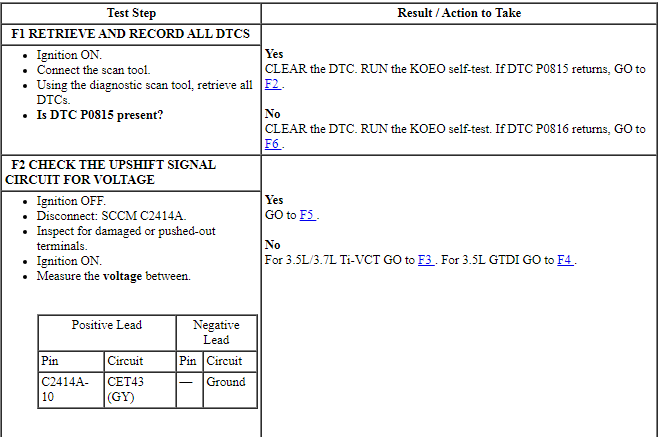
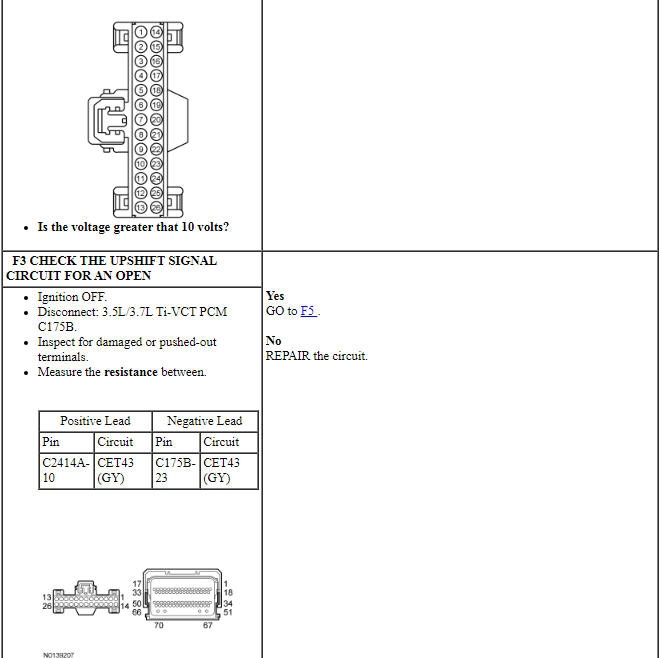
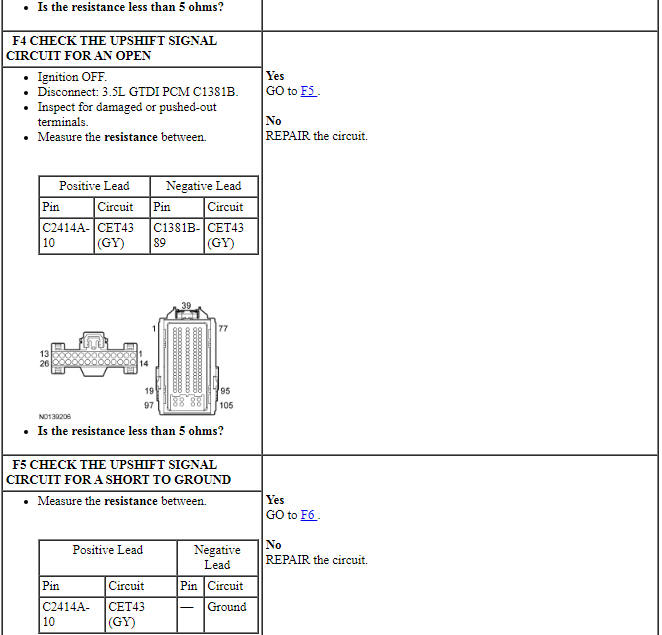
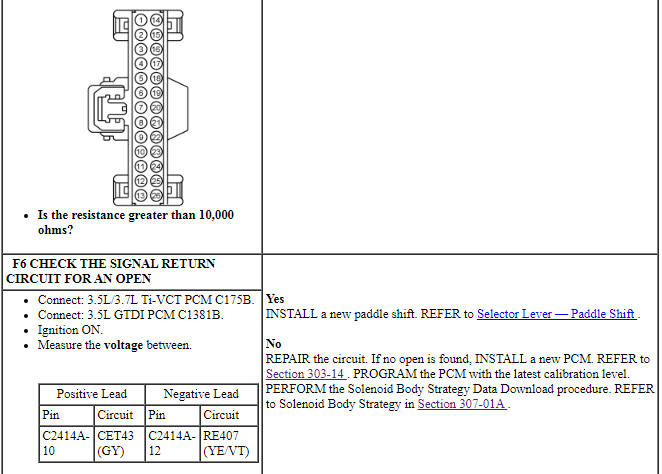
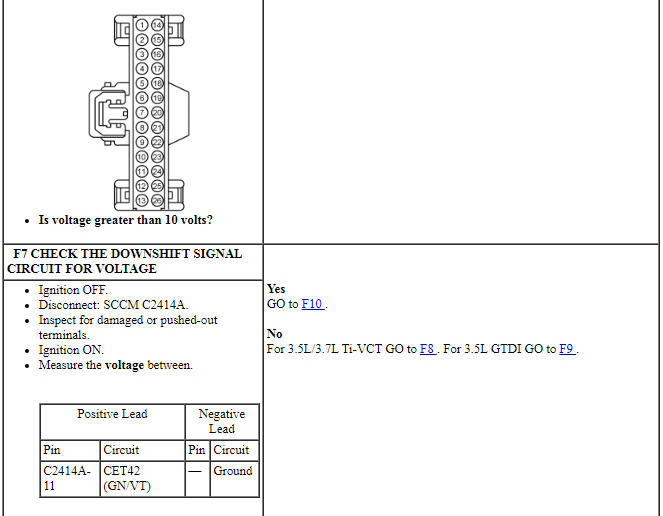
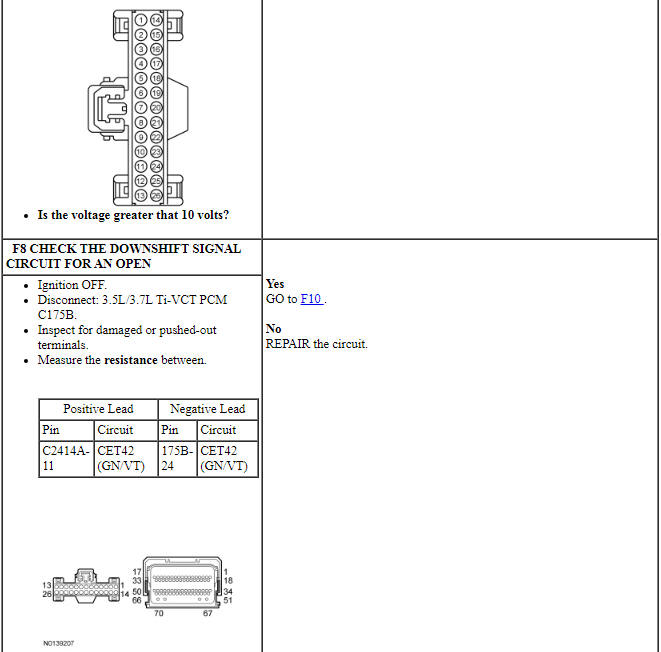
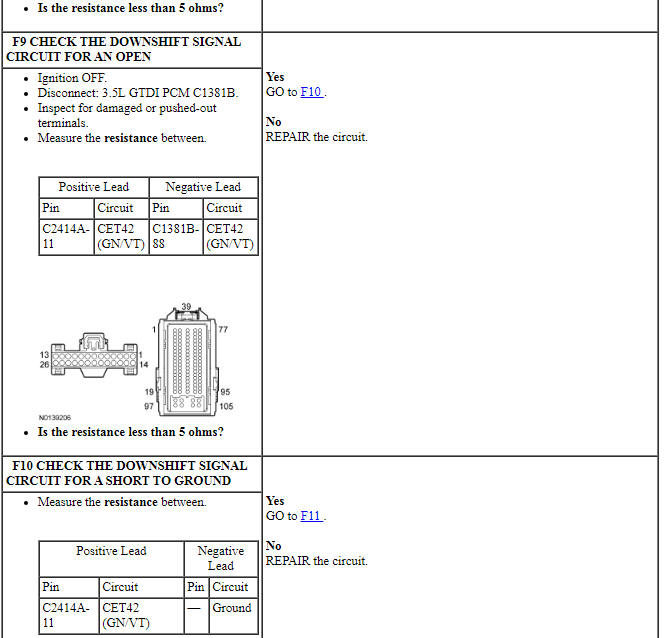
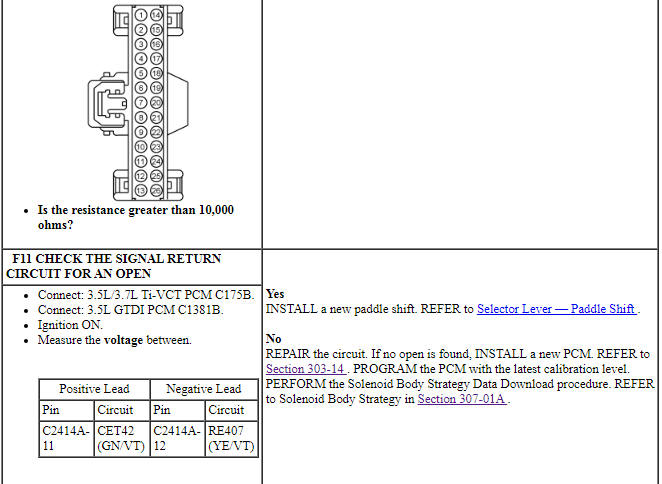
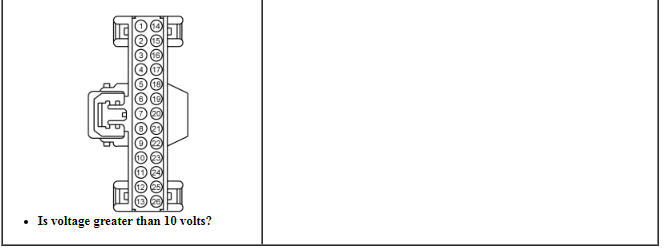
Pinpoint Test G: P1780
Diagnostic Overview
Diagnostics in this manual assume a certain skill level and knowledge of Ford-specific diagnostic practices. Refer to Diagnostic Methods in Section 100-00 for information about these practices.
Refer to Wiring Diagrams Cell 30 , Transmission Controls - 6F35 for schematic and connector information.
Normal Operation and Fault Conditions
The low gear select switch is a momentary contact switch located on the end of the selector lever. Pressing the low gear select switch will allow for low (1st gear) operation or cancel low gear operation. There are no continuous DTCs for the low gear select switch but if the switch fails while the vehicle is being driven, the symptoms is, transmission shifts to low when not selected or transmission will not go into low when selected. This will depend on how and when the switch fails.
DTC Fault Trigger Conditions

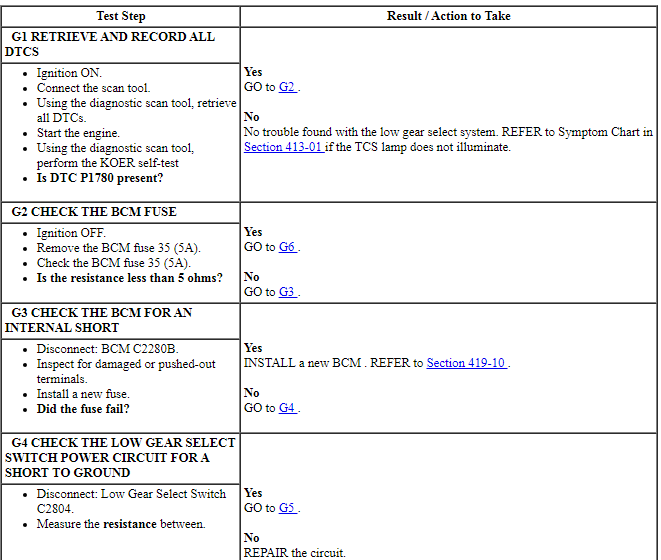

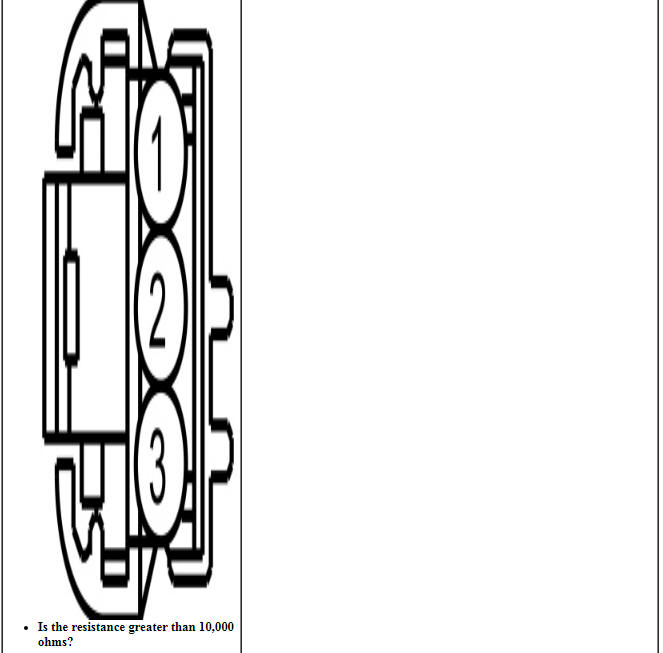
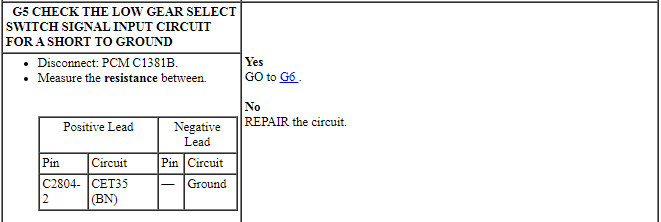
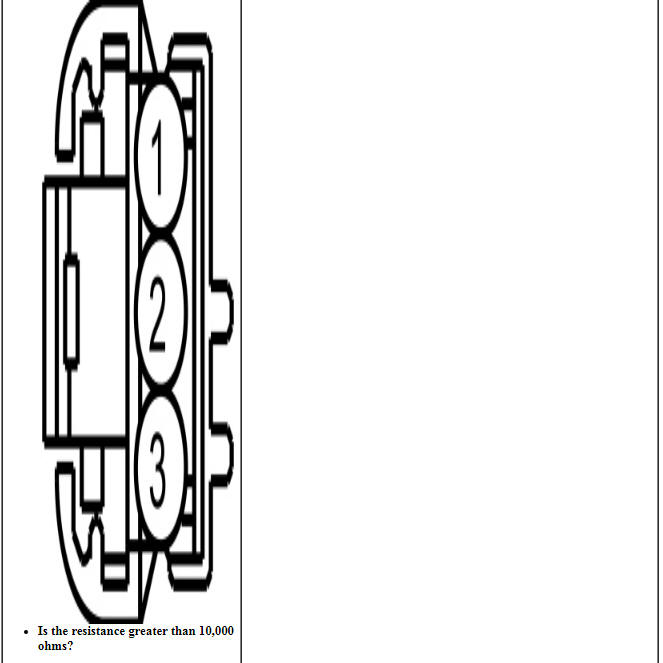
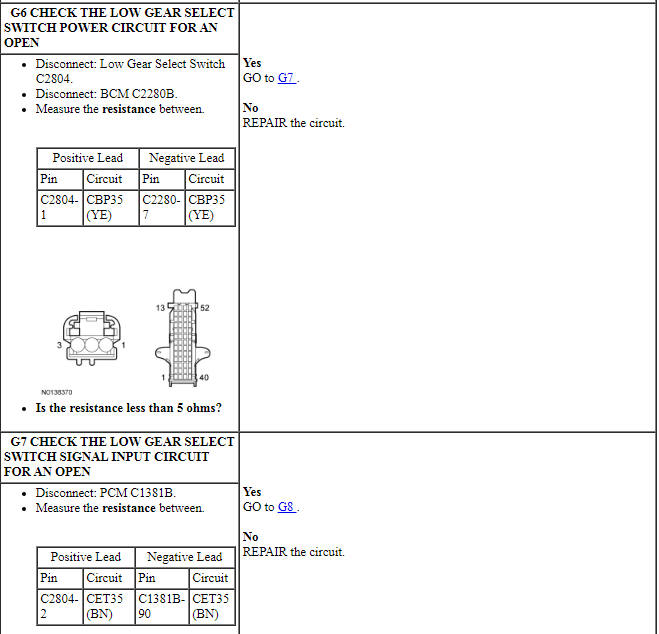
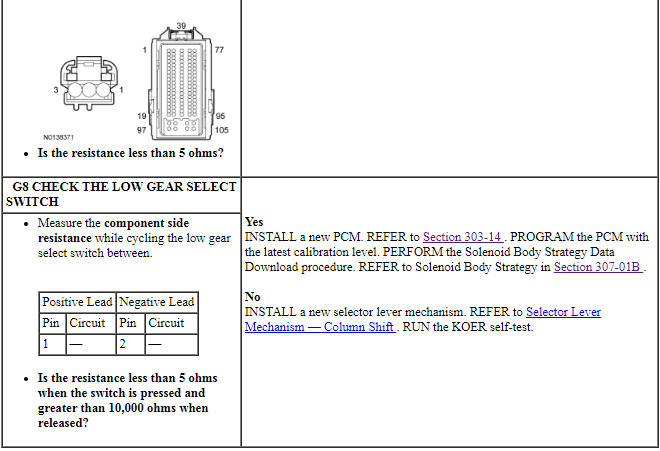
 Specifications, Description and Operation
Specifications, Description and Operation
SPECIFICATIONS
Torque Specifications
DESCRIPTION AND OPERATION
External Controls
The transmission selector lever linkage consists of:
a selector lever cable that connects the transmission manual ...
 General Procedures
General Procedures
Brake Shift Interlock Override - Floor Shift
NOTE: If it is necessary to use the override procedure to move
the selector lever out of the PARK position, it is possible that a fuse has
blown.&nb ...
Other materials:
Steering Column Switches
SPECIFICATIONS
Torque Specifications
DESCRIPTION AND OPERATION
Steering Column Switches
Overview
The steering column switches are located on or around the steering column,
giving the driver the ability to control various vehicle functions and remain
focused on the task of driving. Depending on ve ...
Disassembly and Assembly
Main Control - Overhaul
Special Tool(s)
Main Control
Main Control Valve Body
Solenoid Body
Main Control Valve Body
Check balls
Solenoid damper
NOTICE: Remove the valves by tapping the valve body on the
palm of the hand to slide the valves out ...
General Procedures
Brake Shift Interlock Override - Floor Shift
NOTE: If it is necessary to use the override procedure to move
the selector lever out of the PARK position, it is possible that a fuse has
blown. GO to Pinpoint Test A.
This vehicle is equipped with a brake shift interlock feature that prevent ...
